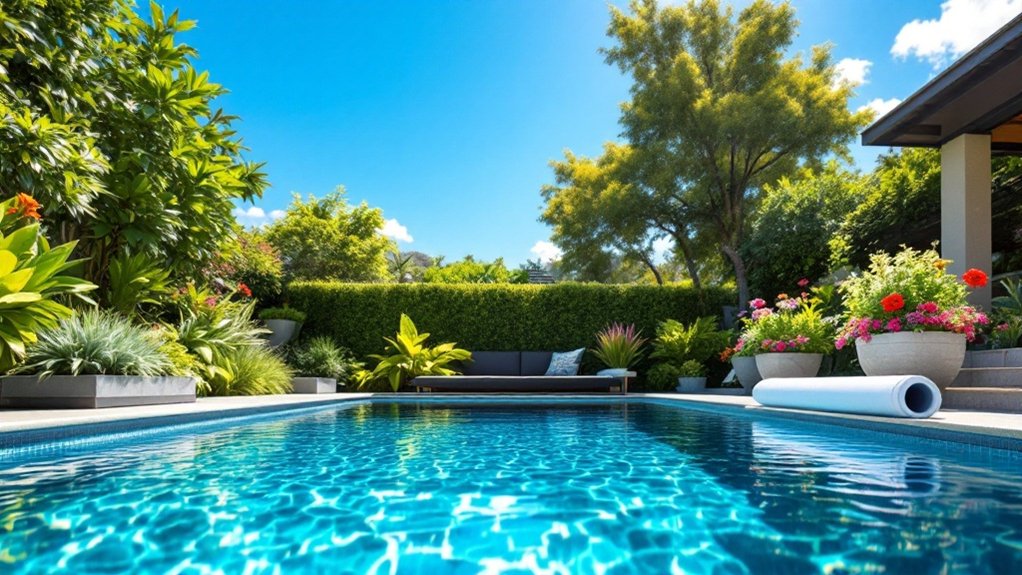The debate between natural pools and traditional pools highlights significant ecological differences. Natural pools utilize biological filtration and aquatic plants, promoting sustainability. In contrast, traditional pools depend on chemical treatments that can harm local ecosystems. While the initial investment for natural pools may be higher, their long-term benefits raise questions about the true cost of pool ownership. As homeowners weigh their options, the implications for health and the environment become increasingly relevant.
Understanding Natural Pools: How They Work
Natural pools, often referred to as swimming ponds, operate on a unique ecological system that mimics nature’s processes to maintain clean and clear water. These pools utilize a combination of biological filtration and plant life to achieve a balanced ecosystem. The water circulates through a regeneration zone, where aquatic plants absorb nutrients and provide habitat for beneficial microorganisms. These organisms break down organic matter, preventing algae blooms and promoting water clarity. Additionally, the absence of harmful chemicals creates a safer swimming environment, appealing to environmentally conscious users. The design of natural pools emphasizes harmony with surrounding landscapes, often integrating rocks, plants, and wildlife. This approach not only enhances aesthetics but also fosters biodiversity, making natural pools a sustainable alternative to traditional swimming facilities.
The Mechanics of Traditional Pools
Traditional pools rely on a systematic approach to maintain water quality and clarity, utilizing chemical treatments and mechanical filtration systems. These pools typically incorporate a pump that circulates water through a filtration system, removing debris and impurities. Chemicals like chlorine are commonly added to disinfect the water and control algae growth, ensuring a safe swimming environment. Regular maintenance tasks include testing water chemistry, adjusting chemical levels, and cleaning the pool surfaces. Additionally, traditional pools often feature skimmers and main drains to assist in collecting debris and maintaining circulation. This mechanical setup is essential for providing a consistent swimming experience, but it demands regular attention and resources to uphold the desired water quality. Furthermore, regular maintenance is crucial to extend the lifespan of pool equipment and prevent costly repairs.
Environmental Impact: A Closer Look
While both types of pools offer the allure of invigorating recreation, their environmental impacts diverge markedly. Traditional pools typically rely on chemical treatments to maintain water clarity and hygiene, which can lead to chemical runoff that adversely affects local ecosystems. In contrast, natural pools utilize biological filtration systems, promoting a self-sustaining environment that fosters biodiversity. This design minimizes chemical usage and encourages the presence of aquatic plants and wildlife. Additionally, natural pools often integrate seamlessly into the landscape, reducing the need for extensive landscaping and artificial materials. Overall, the environmental footprint of traditional pools tends to be considerably larger due to energy consumption and chemical reliance, whereas natural pools present a more sustainable alternative that aligns with eco-friendly practices.
Maintenance Requirements for Each Pool Type
When comparing maintenance requirements, natural pools and traditional pools exhibit distinct differences in cleaning methods and chemical usage. Natural pools rely on biological processes for water clarity, minimizing the need for harsh chemicals, while traditional pools often require regular chemical treatments to maintain hygiene. Additionally, seasonal maintenance varies greatly between the two types, with natural pools typically requiring less intensive care during colder months.
Cleaning Methods Comparison
Although both natural pools and traditional pools offer unique swimming experiences, their cleaning methods and maintenance requirements differ considerably. Traditional pools typically rely on mechanical systems, such as skimmers, vacuums, and filters, to maintain water clarity and hygiene. Regular backwashing of filters and manual cleaning are essential components of their upkeep. In contrast, natural pools utilize biological filtration systems, which involve plants and beneficial bacteria to naturally filter and purify the water. This system requires less frequent manual cleaning, as the ecosystem helps maintain balance. Nevertheless, periodic maintenance, such as trimming aquatic plants and monitoring water levels, remains necessary. Ultimately, the choice between these two cleaning methods reflects not only personal preference but also environmental considerations.
Chemical Use Differences
Natural pools and traditional pools differ greatly in their chemical use, reflecting their distinct approaches to water maintenance. Traditional pools primarily rely on synthetic chemicals, such as chlorine and algaecides, to maintain water clarity and sanitation. This can lead to potential environmental impacts and health concerns for users. In contrast, natural pools utilize biological filtration systems, which harness plants and microorganisms to naturally cleanse the water. Consequently, they require minimal or no chemical additives, promoting a more eco-friendly option. This difference in chemical use not only affects the overall maintenance practices but also influences the long-term sustainability of each pool type. By reducing reliance on harsh chemicals, natural pools contribute to healthier ecosystems while requiring less frequent intervention.
Seasonal Maintenance Needs
Seasonal maintenance needs for natural pools and traditional pools vary considerably due to their differing operational mechanisms. Traditional pools typically require regular chemical balancing, cleaning of filters, and skimming debris throughout the season. Owners must also monitor water levels and guarantee the proper function of pumps and heaters, particularly in colder months.
Conversely, natural pools emphasize ecosystem balance, necessitating less frequent interventions. Maintenance involves monitoring plant health, managing algae growth, and occasionally cleaning the biofilter. Seasonal tasks may include pruning aquatic plants and ensuring adequate water circulation. While traditional pools demand consistent chemical management, natural pools focus on ecological harmony, offering a more sustainable approach to seasonal maintenance. This distinction highlights the commitment required by each pool type throughout the year.
Health Considerations: Water Quality and Safety
Evaluating the health considerations of water quality and safety reveals considerable differences between natural pools and traditional pools. Natural pools utilize a biological filtration system that promotes a balanced ecosystem, often resulting in water that is free from harsh chemicals. This can lead to a reduced risk of skin irritations and allergic reactions in swimmers. In contrast, traditional pools typically rely on chlorine and other chemicals to maintain water clarity and sanitation. While effective, these chemicals can pose health risks, including respiratory issues and skin problems. Additionally, natural pools often maintain a more stable temperature and pH balance, contributing to a more pleasant swimming experience. Ultimately, the choice between the two types of pools can considerably impact the health and safety of their users.
Aesthetic Appeal: Design and Integration
The visual and environmental aspects of pools play a significant role in their overall appeal and functionality. Natural pools, characterized by their organic design, often integrate seamlessly into surrounding landscapes, featuring native plants and natural stone elements. This design enhances biodiversity and promotes a harmonious aesthetic that resonates with nature. Conversely, traditional pools typically adopt a more structured and uniform appearance, often using concrete and tiles, which can clash with the natural environment. While both types can be designed to enhance property value, natural pools tend to evoke a sense of tranquility and connection to nature. Ultimately, the choice between natural and traditional pools hinges on personal preferences regarding aesthetic appeal and how well the pool integrates with the surrounding environment.
Cost Analysis: Initial Investment and Long-term Expenses
Cost considerations play an essential role in deciding between natural and traditional pools. Initial investment for traditional pools typically ranges from $30,000 to $50,000, depending on size and materials. In contrast, natural pools can start at around $50,000, as they require specialized design and construction techniques. However, long-term expenses reveal a different picture. Traditional pools incur ongoing costs for chemicals, maintenance, and energy, which can accumulate considerably over time. Conversely, natural pools, while initially more expensive, often result in lower maintenance costs and minimal chemical use, promoting sustainability. Additionally, natural pools may enhance property value, offsetting initial expenses. Ultimately, the choice hinges on balancing upfront costs with long-term financial implications and environmental considerations.
Frequently Asked Questions
Can Natural Pools Attract Insects or Wildlife More Than Traditional Pools?
The question of insect and wildlife attraction revolves around the ecological characteristics of aquatic environments. Natural pools, with their organic ecosystems, tend to draw more insects and wildlife compared to traditional pools, which are more artificial and sterile.
Are There Any Legal Restrictions for Installing Natural Pools?
When considering the installation of natural pools, various legal restrictions may apply depending on local regulations. These can include zoning laws, water use permits, and environmental protection guidelines, which vary by region and municipality.
How Long Does It Take to Build a Natural Pool?
The construction of a natural pool typically takes between four to eight weeks, depending on various factors such as design complexity, site conditions, and weather. Proper planning and execution can guarantee timely completion of the project.
What Materials Are Commonly Used in Natural Pool Construction?
In constructing natural pools, common materials include gravel, sand, aquatic plants, and natural stone. These components work together to create a self-sustaining ecosystem, enhancing water purification and promoting biodiversity within the pool environment.
Can Natural Pools Be Used in Colder Climates?
Natural pools can indeed be utilized in colder climates, provided they are designed with proper insulation and heating systems. These adaptations help maintain a comfortable water temperature, ensuring usability throughout the colder seasons.
Conclusion
To sum up, the choice between natural pools and traditional pools encompasses a range of ecological, maintenance, and health factors. Natural pools offer sustainable benefits through biological filtration and reduced chemical use, appealing to eco-conscious homeowners. While they may require a higher initial investment, their long-term advantages, including lower maintenance needs and improved water quality, make them a compelling option. Ultimately, homeowners should weigh these considerations to determine the best fit for their lifestyle and environmental values.




